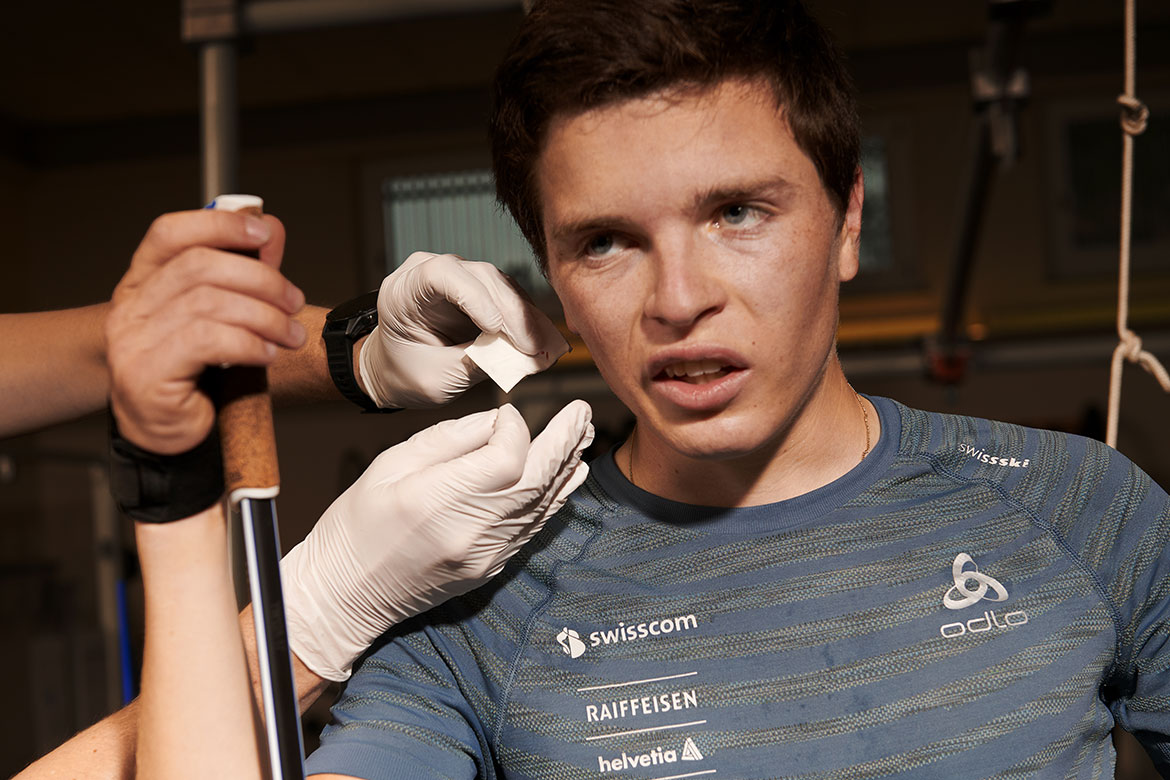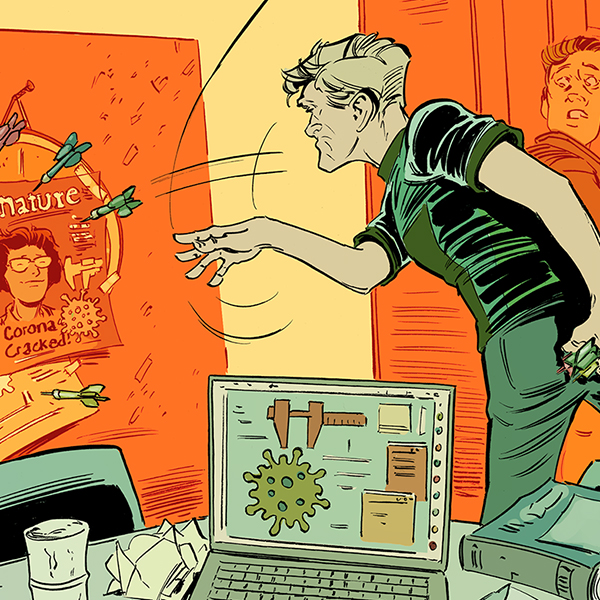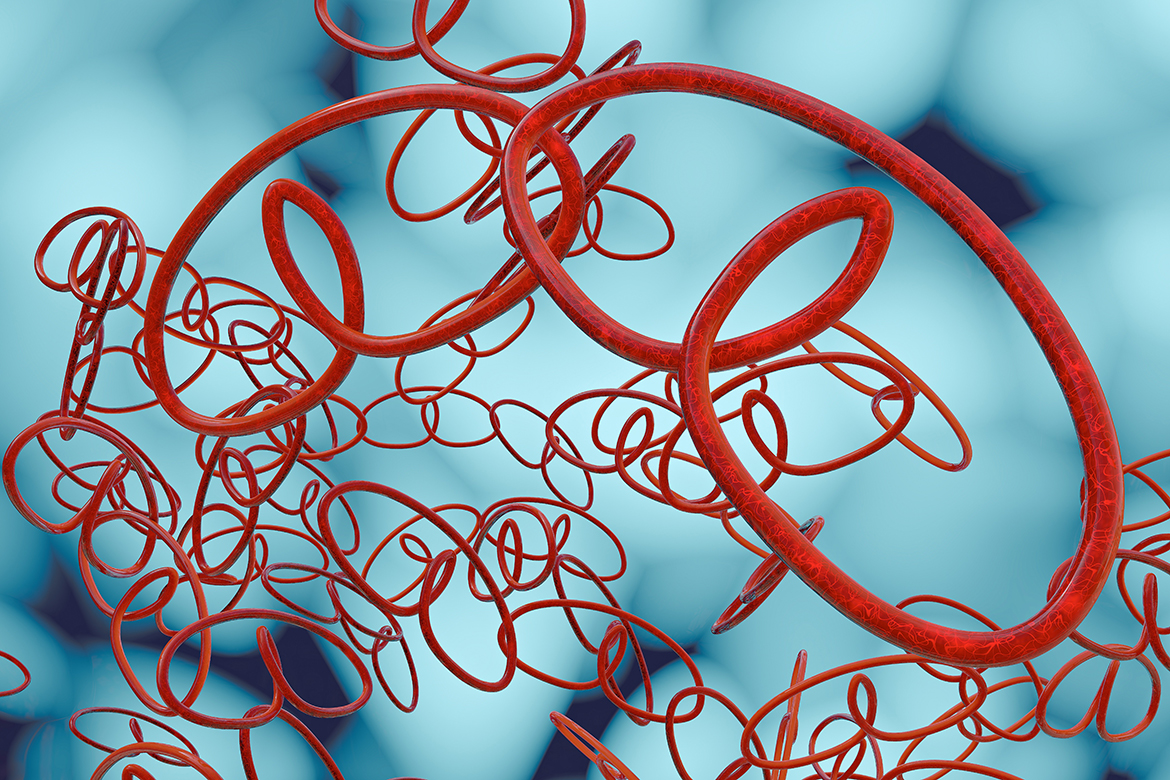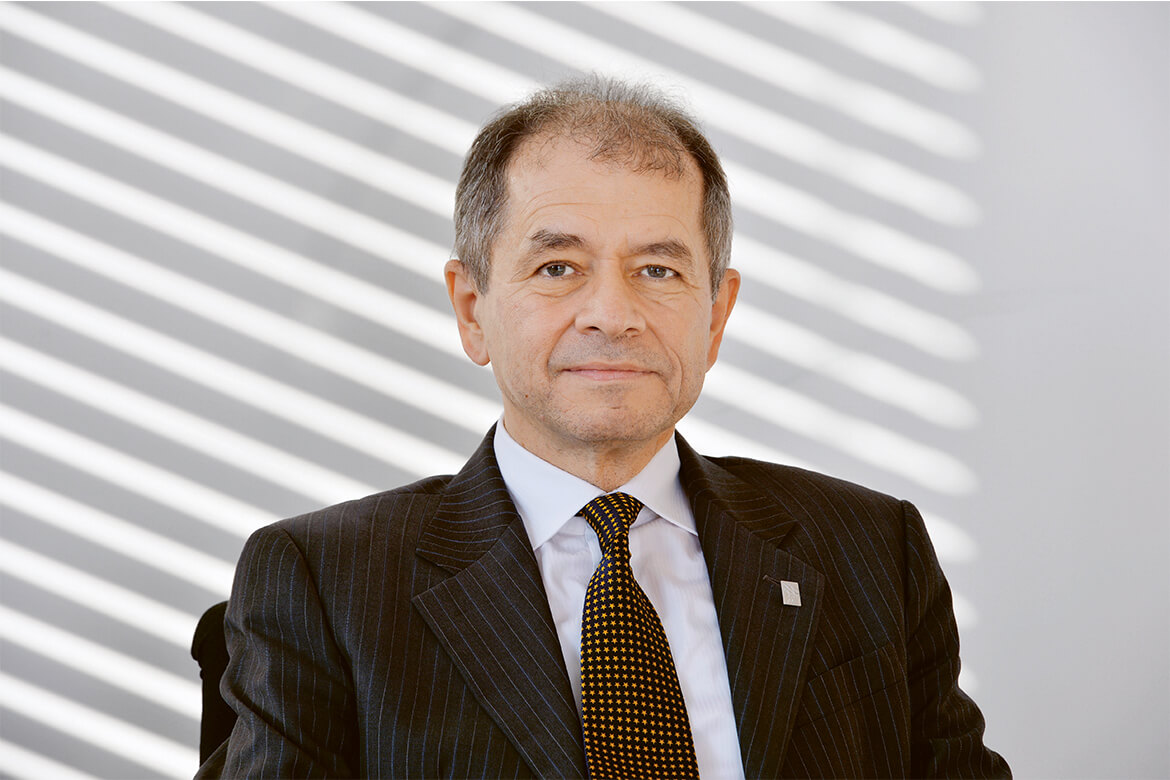FEATURE: SPORTS IN THE LAB
A discipline in its infancy
It’s only in the last two decades that sports science has established itself as an independent scientific discipline in Switzerland. Sports and the academy remain wary of each other, despite increasing numbers of would-be students and the relevance of sports science to many current topics.

This cross-country skier has blood taken from his earlobe at five-minute intervals in order to have a lactate test. This is done at least seven times and continues until he is exhausted. | Photo: Gian Paul Lozza
The word ‘sport’ comes from the Latin ‘disportare’, meaning to amuse oneself or relax. Until the 19th century, sports activities were generally practised by society’s elite in their leisure time – the class of society who actually had time to spare for it. It was only when large swathes of the population were given regular working hours, leisure time and holidays that sports increased in importance as a phenomenon across all society.
Science and scholarship also came late to sports. “To this day, a gap exists in Switzerland between the academy and sports”, says Achim Conzelmann, a professor of sports science at the University of Bern. “Often, people believe that practical knowledge is sufficient to solve problems in sports”. This is because physical activity was long regarded as something to balance out intellectual activity, not as a field that itself requires any intellectual endeavour – and this is an opinion that some still hold today. The beginnings of sports science were accordingly very practice-oriented, and it served primarily to train teachers for gymnastics lessons at school.
No money for research
When the University of Basel established its programme for sports teachers in 1922 – the first of its kind in Switzerland – it offered both practical training and courses that took a scientific approach to sports and movement. However, the science of sport was not regarded as an independent academic discipline, and was instead attached to the medical faculty. “The curriculum was dominated by pedagogics, didactics and practical sports courses. Conducting research would have meant investing more resources and providing the necessary money”, says Uwe Pühse, the chair of the Department of Sport, Exercise and Health at the University of Basel. “At a time when money was tight, the university was not prepared to take that step”.
Even when the Institute of Sports was founded at the University of Basel in 1992, research still played a minor role. “Research took place on evenings and weekends. There was no mid-level faculty at all”, explains Uwe Pühse, who had one of the Institute’s two full-time academic positions when it was set up. He experienced first-hand the challenges of setting up sports science as an independent academic discipline.
Gymnastics as a means of strengthening military defence
What’s more, there was not much leeway in the curriculum for sports teachers at the individual universities back then. “Gymnastics was the only federally mandated school subject in 20th-century Switzerland, at a time when the cantons otherwise had free reign over education”, says Christian Koller. He is a historian, the director of the Swiss Social Archives, and has undertaken thorough research into the history of sports science in Switzerland. The universities essentially trained gymnastics teachers on the orders of the federal government. Their diplomas were signed by the Federal Council, not by the dean of their own university, as was the norm in other subjects. “One reason for this was that sports were seen as a means of strengthening military defence in the late 19th century”, says Koller. For example, diplomas were certified by the Swiss Federal Military Department, and the curriculum for gymnastics teachers at ETH Zurich was under the auspices of the military sciences at the time.
The federal diplomas for gymnastics and sports teachers were only phased out in 2005, when they were replaced by Bachelor and Master degrees. The resulting realignment of the discipline brought about a more integrated, scientific investigation of the field of sports and helped to establish sports science as an academic discipline of its own in Switzerland. “Up to that point, any scientific engagement with sports in Switzerland was limited to specific fields such as biomechanics or the medical disciplines”, says Christina Spengler, the vice-president of the Swiss Society for Sports Science and a professor of human movement sciences at ETH Zurich.
“We don’t need to fear any comparisons”
The increased importance of sport in society in the second half of the 20th century was also a major factor in the successful institutionalisation of sport at our universities. The significance of sports was similarly manifested by the inclusion of an article on sports in the Federal Constitution in 1970, by the subsequent Federal Act on the Promotion of Sport and Exercise, and by the creation of the Swiss Federal Office of Sport (BASPO) in Magglingen in 1998. The foundation of BASPO was also important because it meant that federal research monies were now made available for sports science projects. But there were also certain individuals who doggedly campaigned for university managements to acknowledge the necessity of research in sports science. Their commitment proved decisive too.
Between 2005 and 2010, numerous universities in Switzerland established chairs in sports science. The concomitant support for young academics also helped to earn sports science recognition as an independent scholarly discipline. They were from now on entitled to take doctorates in sports science and to pursue their postdoctoral ‘Habilitation’ qualifications. They engaged in research activities, began to acquire third-party research funds, and also started publishing in renowned specialist journals. “The reputation of sports science has grown considerably in recent years”, says Uwe Pühse. This fact is also confirmed by Achim Conzelmann: “If you compare the scholarly output of sports science with other disciplines in the social and behavioural sciences, then we don’t need to fear any comparisons today”.
A ‘second-class’ science?
Sports science examines a broad spectrum of topics, ranging from reducing mental stress through sports to mobility after a stroke, and even to whether or not it is harmful to wear a hygiene mask in a fitness studio. Many of these issues could also be answered by more established academic disciplines such as psychology or medicine. So why does sports science need to be an independent scientific discipline?
Achim Conzelmann is often faced with this question, because sports science still has to keep justifying its existence, even after having been established as a discipline in the academy. It has often been regarded as a ‘second-class science’. But sports science isn’t alone in this. “All the less traditional subjects have to prove their societal relevance”, says Conzelmann. Sports science has a big advantage, however, in that it is devoted to a subject that has a high degree of societal relevance. The research questions it deals with are very diverse, and sport itself is a complex phenomenon, so an interdisciplinary approach is necessary. “It’s in this interdisciplinary nature that the strength and legitimacy of sports science lie”, he says.
Sports science takes its cue from the fact that sports are complex biological, social and psychological activities that require a holistic, scientific perspective. “Sports promote the motor development of children, they’re a fixed component of our education system, they fulfil an important social function in the shape of sports associations, and they contribute to a healthy lifestyle”, says Uwe Pühser. Christina Spengler is of a similar opinion: “The different facets of sport have to be seen as a whole”, she says. She is convinced that this is also a prerequisite if academic circles are going to take more notice of sports.
No problems with young blood here
The fact that there is a great interest in studying sports science is proof of its considerable popularity. In the academic year 2020/21, the Federal Statistical Office recorded more than 2,000 students enrolled in sports science at Swiss universities. This is still a small number when compared to booming subjects such as business sciences with its roughly 23,000 students. But all the same, some universities have started to introduce aptitude tests. This is partly because – as in Basel – applications for sports science courses exceed the number of places available, but also because many interested students still want to teach sports, and so they have to be able to demonstrate certain motor skills.
But don’t the universities potentially lose out on a lot of gifted young scientists by insisting on aptitude tests for physical abilities? “No”, says Roberta Antonini Philippe, a specialist in sports psychology at the University of Lausanne, who is the committee member of the Swiss Society for Sports Science responsible for promoting young talent. “Many of our students want to become sports teachers, not academics. That justifies assessing their physical competence”. And Christina Spengler also emphasises that sports science doesn’t have any problems finding talented young academics – far from it. “Many of our doctoral students conduct scientific research outside the university system once they’ve graduated – at clinics or rehabilitation centres, for example. There are not enough jobs at universities for junior academics”.
Good omens for the increasing importance of sports science
Sports science is a rapidly growing discipline. And although its relative youth means it’s often still regarded with some scepticism, the omens for it in society as a whole are good. The eminent importance of exercise for our health is becoming increasingly obvious, given the demographic ageing of the population. At the same time, a lack of exercise is regarded as one of the biggest health challenges of our time, and sport has the potential to have a positive, medical impact on our physical and mental health. It will become increasingly important in future for us to subject these phenomena and interconnections to further research.




